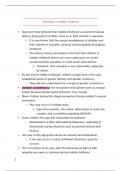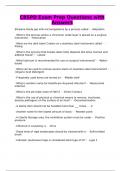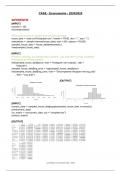Brain & behaviour summary
L1 introduction
Central nervous system = CNS = brain + spinal chord
Peripheral nervous system = PNS = sensory receptors + neurons
Nervous system spatial scales:
• Nervous system
o Central nervous system = CNS = brain + spinal chord
o Peripheral nervous system = PNS = sensory receptors + neurons
• System: parallel computations
o nodes
• Map
o Sensory = sensors
o Motor = skeletal muscles
o Cognitive = space that surrounds us
• Network
• Neuron
o Dendrite
o Axon
o soma
• Synapse
o Chemical: neurotransmitters & receptors
o Electrical: channels & ions
• Molecule, ex. neurotransmitters
Brain regions = neurons that are functionally clustered or have the same cortical structure
Identification:
• MRI: more blood -> more oxygen -> neural activity
• PET = radioactive tracking in blood
• Nissl staining (post mortem): express proteins -> soma
,L2 introduction pt. 2
Neurons:
• Small soma, small projections = local connections
• Large soma = long distance connections
Synapses:
• Electrical = have pores that connect
neurons, directly transfer ions.
Bidirectional & fast. (b)
• Chemical = release vessels with
neurotransmitters to receptors.
Unidirectional. (a)
Not all neurotransmitters in vessel.
Neurotransmitter on receptor -> calcium influx
Neurotransmitters:
• Amino acids
o Glutamate
o Glycine
o GABA
• Amines
o Dopamine
o Acetylcholine
o Histamine
• Peptides
o Dynorphin
o enkephalins
Glial cells:
• Oligodendrocytes (CNS) = myelination
• Astrocytes (CNS) = support
• Schwann cells (PNS) = myelination
, L3 membrane potential
Bilipid membrane: hydrophilic heads, hydrophobic tails + 50% proteins (oa ion channels)
Permeable for small, non-charged molecules,
Impermeable for ions -> regulatable -> charge difference -> voltage
Trans membrane voltage = Vm
Voltage = difference in electrical potential between 2 points (inside vs outside of cell)
Measuring membrane potential:
• Microelectrode in cell, reference electrode outside cell -> toxic
• Patch clamping = glass pipette pops membrane -> can be done in vitro
Stimulating neuron = introduce current to cell -> changes membrane potential
Membrane potential is very local, around the cell membrane
Steady cell: negative charged inside = negative Vm
Ion pumps create & maintain concentration gradients of ions.
Sodium-potassium pump = 3x Na+ out, 2x K+ in -> makes less positive (more negative)
Makes Na+ abundant outside, K+ abundant inside
Always on, but is slow. Uses ATP
At rest: K+ channels open, Na+ channels closed
Chemical potential = diffusion because uneven concentrations (usually low outside)
Electrical potential = flux because uneven charge (usually inside negative)
If chemical potential is with ions, it can generate a voltage across the membrane and thus an
electrical potential. They will then move till they match one another.
Ions flow via ion channels:
• Always open = leak channels
• Gateable channels
o Voltage sensitive
o Ligand sensitive
𝑅𝑇 [𝑖𝑜𝑛]
Nernst Equation = 𝐸 = 𝑧𝐹
ln( [𝑖𝑜𝑛]𝑜𝑢𝑡 )
𝑖𝑛
• Relation between chemical and electrical potential (= Nernst potential) for one ion
• When Vm = E, the is no flow over the membrane
L1 introduction
Central nervous system = CNS = brain + spinal chord
Peripheral nervous system = PNS = sensory receptors + neurons
Nervous system spatial scales:
• Nervous system
o Central nervous system = CNS = brain + spinal chord
o Peripheral nervous system = PNS = sensory receptors + neurons
• System: parallel computations
o nodes
• Map
o Sensory = sensors
o Motor = skeletal muscles
o Cognitive = space that surrounds us
• Network
• Neuron
o Dendrite
o Axon
o soma
• Synapse
o Chemical: neurotransmitters & receptors
o Electrical: channels & ions
• Molecule, ex. neurotransmitters
Brain regions = neurons that are functionally clustered or have the same cortical structure
Identification:
• MRI: more blood -> more oxygen -> neural activity
• PET = radioactive tracking in blood
• Nissl staining (post mortem): express proteins -> soma
,L2 introduction pt. 2
Neurons:
• Small soma, small projections = local connections
• Large soma = long distance connections
Synapses:
• Electrical = have pores that connect
neurons, directly transfer ions.
Bidirectional & fast. (b)
• Chemical = release vessels with
neurotransmitters to receptors.
Unidirectional. (a)
Not all neurotransmitters in vessel.
Neurotransmitter on receptor -> calcium influx
Neurotransmitters:
• Amino acids
o Glutamate
o Glycine
o GABA
• Amines
o Dopamine
o Acetylcholine
o Histamine
• Peptides
o Dynorphin
o enkephalins
Glial cells:
• Oligodendrocytes (CNS) = myelination
• Astrocytes (CNS) = support
• Schwann cells (PNS) = myelination
, L3 membrane potential
Bilipid membrane: hydrophilic heads, hydrophobic tails + 50% proteins (oa ion channels)
Permeable for small, non-charged molecules,
Impermeable for ions -> regulatable -> charge difference -> voltage
Trans membrane voltage = Vm
Voltage = difference in electrical potential between 2 points (inside vs outside of cell)
Measuring membrane potential:
• Microelectrode in cell, reference electrode outside cell -> toxic
• Patch clamping = glass pipette pops membrane -> can be done in vitro
Stimulating neuron = introduce current to cell -> changes membrane potential
Membrane potential is very local, around the cell membrane
Steady cell: negative charged inside = negative Vm
Ion pumps create & maintain concentration gradients of ions.
Sodium-potassium pump = 3x Na+ out, 2x K+ in -> makes less positive (more negative)
Makes Na+ abundant outside, K+ abundant inside
Always on, but is slow. Uses ATP
At rest: K+ channels open, Na+ channels closed
Chemical potential = diffusion because uneven concentrations (usually low outside)
Electrical potential = flux because uneven charge (usually inside negative)
If chemical potential is with ions, it can generate a voltage across the membrane and thus an
electrical potential. They will then move till they match one another.
Ions flow via ion channels:
• Always open = leak channels
• Gateable channels
o Voltage sensitive
o Ligand sensitive
𝑅𝑇 [𝑖𝑜𝑛]
Nernst Equation = 𝐸 = 𝑧𝐹
ln( [𝑖𝑜𝑛]𝑜𝑢𝑡 )
𝑖𝑛
• Relation between chemical and electrical potential (= Nernst potential) for one ion
• When Vm = E, the is no flow over the membrane










